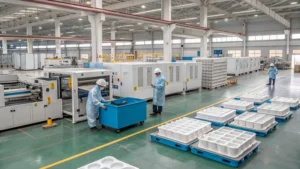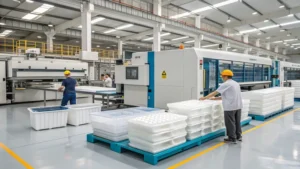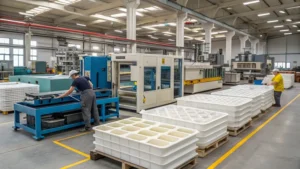
Polypropylene (PP) thermoformed sheets are a versatile and cost-effective solution for industries ranging from packaging to automotive. But how are these sheets made, and what makes them so special? In this blog post, we’ll dive into the process of creating PP thermoformed sheets1, exploring everything from the basics to technical details, and provide practical tools to help you make informed decisions.
- 1. What are PP Thermoformed Sheets?
- 2. What are the Common Types of PP Used in Thermoforming?
- 3. What are the Steps in the PP Thermoforming Process?
- 4. What are the Key Design Considerations for PP Thermoformed Sheets?
- 5. What are the Applications of PP Thermoformed Sheets?
- 6. How Does PP Thermoforming Compare to Other Processes?
- 7. What are the Challenges in PP Thermoforming?
- 8. Conclusion
What are PP Thermoformed Sheets?
PP thermoformed sheets are created by heating polypropylene2 sheets to a pliable state and shaping them using molds. This process is widely adopted due to its efficiency and PP’s unique properties, such as being lightweight and chemically resistant.
Polypropylene (PP) is a thermoplastic polymer known for its low density, high chemical resistance, and good mechanical properties. Thermoforming involves heating a plastic sheet to a pliable state (165-180°C for PP), stretching it over a mold using vacuum, pressure, or mechanical force, and cooling it to retain the shape.

Understanding this process and its applications is key to unlocking the benefits of PP thermoformed sheets in your industry. Read on to discover how different PP grades and design choices influence the final product.
PP thermoformed sheets are only used in packaging applications.False
While common in packaging, PP thermoformed sheets also find applications in medical, automotive, and consumer goods industries due to their versatility.
What are the Common Types of PP Used in Thermoforming?
Different grades of PP are utilized in thermoforming, each with distinct properties tailored to specific applications.

Common PP types for thermoforming include homopolymer PP3 for stiffness, impact copolymer PP4 for durability, and random copolymer PP5 for flexibility, used in packaging, medical, and automotive industries.
| Material Type | Characteristics | Applications |
|---|---|---|
| Homopolymer PP | High stiffness, good heat resistance | Hot fill, microwave applications |
| Impact Copolymer PP | Enhanced impact resistance, lower clarity | Freezer-microwave use |
| Random Copolymer PP | Flexible, good for refrigerated applications | Refrigerated packaging |
| Filled PP | Improved stiffness with fillers (e.g., talc, calcium carbonate) | Structural parts |
| Multi-layer PP | Barrier properties for oxygen/moisture, used in packaging | Oxygen-sensitive packaging |
Homopolymer PP
Homopolymer PP offers high stiffness and heat resistance, making it perfect for hot fill and microwave-safe packaging. However, its brittleness requires careful handling during thermoforming.
Impact Copolymer PP
Impact copolymer PP provides enhanced impact resistance, ideal for durable products like freezer-to-microwave containers. Its lower clarity limits its use in applications needing transparency.
Random Copolymer PP
Random copolymer PP is flexible and excels in refrigerated environments, making it a top choice for food packaging. Its flexibility also aids in forming deeper draws.
All PP grades are equally suitable for thermoforming.False
Different PP grades have varying properties that affect their suitability for specific applications and forming conditions.
What are the Steps in the PP Thermoforming Process?
The creation of PP thermoformed sheets involves two primary stages: sheet production and thermoforming. Precision at each step ensures a high-quality final product.
The PP thermoforming process6 includes extruding PP sheets, heating them to 165-180°C, forming them over a mold using vacuum or pressure, and cooling to set the shape, used in packaging, medical, and automotive industries.

Sheet Production
-
Raw Material Preparation: PP resin7 is pre-crystallized to enhance processing stability.
-
Extrusion: Resin is melted and compressed in an extruder.
-
Filtration and Pumping: Molten PP is filtered to remove impurities.
-
Co-extrusion (if applicable): Used for multi-layer sheets like PP-EVOH-PP.
-
Die Forming: Material is evenly shaped in the die head.
-
Cooling and Shaping: Sheets are cooled via three-roll sheeting.
-
Cutting: Waste edges are trimmed to size.
-
Final Cooling: Sheets are naturally cooled and conveyed.
Thermoforming
-
Heating: PP sheets are heated to 165-180°C.
-
Forming: Softened sheets are stretched over a mold using vacuum, pressure, or mechanical force.
-
Cooling: Formed sheets are cooled to solidify the shape.
-
Trimming and Finishing: Excess material is removed, and secondary operations like printing are applied.
The thermoforming process always results in uniform thickness.False
PP’s low melt strength can cause sagging and uneven thickness, especially in deep draws.
What are the Key Design Considerations for PP Thermoformed Sheets?
Designing for PP thermoformed sheets requires specific guidelines to ensure functionality and manufacturability.

Key design considerations include draft angles8 (3-4° for male molds), limiting draw ratio9s to 1:1, avoiding undercuts, and accounting for PP’s shrinkage and warpage.
| Design Aspect | Recommendation |
|---|---|
| Draft Angles | 3-4° for male molds, 1.5-2° for female molds |
| Draw Ratio | Limit to 1:1 for standard processes |
| Undercuts | Avoid; small undercuts10 possible with thin parts or moveable molds |
| Tolerances | Forming: +/- 0.030” up to 12”; Trim-trim: +/- 0.015” up to 12” |
| Shrinkage and Warpage | Increase crystallinity, use small spherulites |
| Secondary Operations | Use special adhesives, riveting, ultrasonic welding, or painting |
Draft Angles
Draft angles facilitate part removal from molds. For PP, use 3-4° for male molds and 1.5-2° for female molds, with larger angles for deep draws or textured surfaces.

Draw Ratio
Limit the draw ratio (depth-to-width) to 1:1 for standard processes to avoid thinning or part failure.
Undercuts
Avoid undercuts to simplify molding. Small undercuts are possible with thin parts or moveable mold sections.
PP thermoformed sheets can be designed with complex undercuts without issues.False
Undercuts complicate the molding process and should be avoided or minimized in design.
What are the Applications of PP Thermoformed Sheets?
PP thermoformed sheets shine across industries due to their versatility, affordability, and eco-friendly attributes.
PP thermoformed sheets are used in packaging, medical, automotive, and consumer goods for their lightweight, chemical resistance11, and recyclability12.

Packaging
Ideal for food trays, blister packs, and containers, PP offers moisture barriers and food-safe properties, extending to cosmetics and electronics packaging.
Medical Industry
Used for sterile packaging and medical trays, PP ensures hygiene and chemical resistance for items like surgical instrument trays.
Automotive
Lightweight and durable, PP is perfect for interior components like dashboards, enhancing fuel efficiency.

Consumer Goods
From cases to display stands and stationery, PP’s flexibility and cost-effectiveness make it a popular choice.
PP thermoformed sheets are unsuitable for high-temperature applications.False
Homopolymer PP, with its high heat resistance, is suitable for hot fill and microwave applications.
How Does PP Thermoforming Compare to Other Processes?
PP thermoforming has unique strengths and limitations when compared to alternative plastic forming methods.
PP thermoforming is cost-effective for large parts13 and offers recyclability, but it’s less suitable for complex geometries14 compared to injection molding or blow molding.

Comparison with Injection Molding
-
Cost: Lower tooling costs make thermoforming economical for large parts.
-
Complexity: Injection molding excels in complex, precise geometries.
Comparison with Blow Molding
-
Detail: Thermoforming provides better detail for flat or shallow parts15.
-
Hollow Structures: Blow molding suits hollow items like bottles.
Vacuum Forming vs. Pressure Forming
-
Vacuum Forming: Simple and cost-effective for shallow parts.
-
Pressure Forming: Offers sharper edges for detailed applications.
PP thermoforming is the only process for creating plastic sheets.False
There are various processes for creating plastic sheets, including injection molding, blow molding, and rotational molding, each with its own advantages.
What are the Challenges in PP Thermoforming?
Despite its advantages, PP thermoforming presents challenges that require careful management.
Challenges in PP thermoforming include managing PP’s low melt strength, which can cause sagging, and its uneven shrinkage, which may lead to warpage.

Low Melt Strength
PP’s low melt strength can lead to sagging during heating, causing uneven thickness, especially in deep draws.
Uneven Shrinkage
PP’s uneven shrinkage can result in warpage. Mitigate this by increasing crystallinity and using small spherulites.
Limited Clarity
Standard PP grades lack clarity, though clarified PP can be used for transparent needs like cosmetic packaging.
PP thermoforming always results in clear, transparent parts.False
Standard PP grades have limited clarity; clarified PP is needed for transparent applications.
Conclusion
Making PP thermoformed sheets involves a meticulous process of sheet production and thermoforming, with attention to material grades and design guidelines. By mastering this process, its applications, and related technologies, manufacturers can harness PP’s strengths for cost-effective, recyclable, and versatile products.
-
Explore the advantages of PP thermoformed sheets and how they can enhance efficiency and cost-effectiveness in your industry. ↩
-
Discover the unique properties of polypropylene and its diverse applications, which can inform your material choices in production. ↩
-
Explore the advantages of homopolymer PP for packaging applications, including its stiffness and heat resistance. ↩
-
Learn how impact copolymer PP improves durability in products, making it ideal for various applications. ↩
-
Discover why random copolymer PP is preferred for refrigerated packaging due to its flexibility and performance. ↩
-
Explore this link to understand the detailed steps and applications of the PP thermoforming process in various industries. ↩
-
Learn about PP resin's properties and its crucial role in manufacturing high-quality thermoformed products. ↩
-
Understanding draft angles is crucial for successful mold design and part removal, ensuring efficiency in production. ↩
-
Exploring draw ratio impacts can help optimize designs and prevent part failures during manufacturing. ↩
-
Learning about undercuts can guide you in making informed design choices that enhance manufacturability. ↩
-
Learn about the importance of chemical resistance in medical applications, ensuring safety and reliability in healthcare products. ↩
-
Discover the significance of recyclability in packaging, promoting sustainability and environmental responsibility in product design. ↩
-
Explore this link to understand how cost-effective methods can optimize production for large plastic components. ↩
-
Discover why injection molding is preferred for intricate designs and how it can enhance product quality. ↩
-
Learn how thermoforming achieves superior detail in specific applications, making it a valuable technique in manufacturing. ↩








